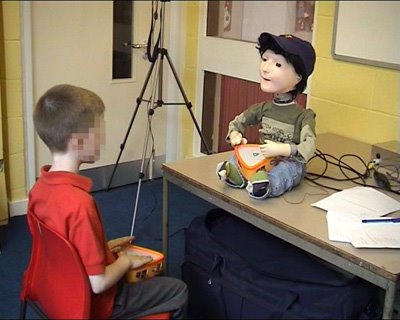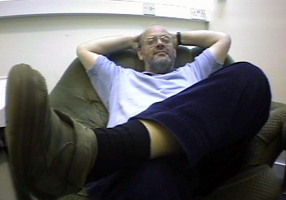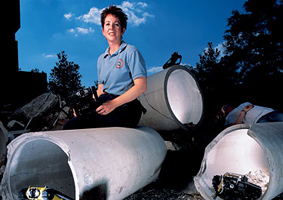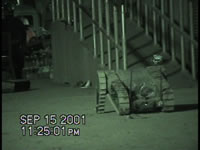New Podcast
|
|
Check out Robots, the new podcast for news and views on robotics. |
 With 45 interviews with high profile people in robotics, nearly 200'000 downloads and a good insight on today's and tomorrow's robotics,here we are now with the final episode of Talking Robots dedicated to what the general public thinks about robots.
With 45 interviews with high profile people in robotics, nearly 200'000 downloads and a good insight on today's and tomorrow's robotics,here we are now with the final episode of Talking Robots dedicated to what the general public thinks about robots.
New Robots Podcast in iTunes
|
New Robots RSS feed |
Links:
Congratulations for the great job you did since the first podcast!
I really hope to find - on the new Robots - the same quality of the contributions that I got used to listen here.
-yup congrats too- I hope your new endeavors will be as good as the past shows.
all the best from Germany.
I was so disappointed that the Talking Robots podcast was coming to an end. Now I am immensely relieved & delighted that the new Robots podcast will emerge from the ashes and carry on. And I'm glad the existing run of podcasts remain available online -- they are a tremendous resource. I hope the new Robots podcast will continue to deal with the topic in the same broad way, including discussions of Artificial Intelligence, Language Acquisition, etc., that the original Talking Robots podcast did so well.
Congratulations! I really enjoyed these podcasts. They have been very inspiring. I was in shock when I looked for an update and it said FINAL. aaaarrgggg!! ....oh, what? robots? oh, wow, thats even better, more official sounding than talking robots which is sort of "nitch market" sounding. (but I love the nitch) hurray!
 In this episode of Talking Robots we speak with Henry Markram who is the director of the Blue Brain Project, director of the Center for Neuroscience & Technology and co-director of EPFL's Brain Mind Institute in Switzerland.
In this episode of Talking Robots we speak with Henry Markram who is the director of the Blue Brain Project, director of the Center for Neuroscience & Technology and co-director of EPFL's Brain Mind Institute in Switzerland.
Links:
 In this episode of Talking Robots we speak with Yoky Matsuoka who is the director of the Neurobotics Laboratory at the University of Washington in Seattle, USA.
In this episode of Talking Robots we speak with Yoky Matsuoka who is the director of the Neurobotics Laboratory at the University of Washington in Seattle, USA.
Links:
 In this episode of Talking Robots we interview Cynthia Breazeal who is an Associate Professor of Media Arts and Sciences at the Massachusetts Institute of Technology in the USA, where she founded and directs the Personal Robots Group at the Media Lab.
In this episode of Talking Robots we interview Cynthia Breazeal who is an Associate Professor of Media Arts and Sciences at the Massachusetts Institute of Technology in the USA, where she founded and directs the Personal Robots Group at the Media Lab.
Links:
 In this episode we interview Kerstin Dautenhahn who is Research Professor in the School of Computer Science, Faculty of Engineering and Information Sciences at University of Hertfordshire in the UK, where she is a coordinator of the Adaptive Systems Research Group.
In this episode we interview Kerstin Dautenhahn who is Research Professor in the School of Computer Science, Faculty of Engineering and Information Sciences at University of Hertfordshire in the UK, where she is a coordinator of the Adaptive Systems Research Group.

Links:
 In this episode we interview Frederic Kaplan. After ten years of research at the Sony Computer Science Laboratory in Paris, he is now researcher at the CRAFT at the EPFL in Lausanne Switzerland where he supervises a new team focusing on interactive furniture and robotic objects.
In this episode we interview Frederic Kaplan. After ten years of research at the Sony Computer Science Laboratory in Paris, he is now researcher at the CRAFT at the EPFL in Lausanne Switzerland where he supervises a new team focusing on interactive furniture and robotic objects.
Links:
 In this episode we interview Brad Nelson who is the Professor of Robotics and Intelligent Systems at ETH Zürich.
In this episode we interview Brad Nelson who is the Professor of Robotics and Intelligent Systems at ETH Zürich.
Links:
 In this episode we interview Inman Harvey who is researcher at the Center for Computational Neuroscience and Robotics at the University of Sussex and faculty of the Evolutionary and Adaptive Systems Group at the same university.
In this episode we interview Inman Harvey who is researcher at the Center for Computational Neuroscience and Robotics at the University of Sussex and faculty of the Evolutionary and Adaptive Systems Group at the same university.Links:
Thank you! Very interesting
I agree with dennis
Me too. Nice post
 In this podcast we interview Robin Murphy who is a founder and international leader in both rescue robotics and human-robot interaction, and was recognized by TIME Magazine in 2004 as an innovator in artificial intelligence. Her work in rescue robotics began in 1995, investigating artificially intelligent robots and new concepts of cooperative teams such as marsupial and heterogeneous teams, while also working directly with responders to establish the domain theory. As the Director of the Center for Robot-Assisted Search and Rescue (CRASAR) at the University of South Florida she was the first to introduce ground, air, and sea robots to disaster response, participating in the World Trade Center disaster (2001), La Conchita, CA, mudslides (2005), Hurricanes Charley (2004), Dennis (2005), Katrina (2005), and Wilma (2005), and the Newmont Midas (2007) and Crandall Canyon (2007) mine disasters.
In this podcast we interview Robin Murphy who is a founder and international leader in both rescue robotics and human-robot interaction, and was recognized by TIME Magazine in 2004 as an innovator in artificial intelligence. Her work in rescue robotics began in 1995, investigating artificially intelligent robots and new concepts of cooperative teams such as marsupial and heterogeneous teams, while also working directly with responders to establish the domain theory. As the Director of the Center for Robot-Assisted Search and Rescue (CRASAR) at the University of South Florida she was the first to introduce ground, air, and sea robots to disaster response, participating in the World Trade Center disaster (2001), La Conchita, CA, mudslides (2005), Hurricanes Charley (2004), Dennis (2005), Katrina (2005), and Wilma (2005), and the Newmont Midas (2007) and Crandall Canyon (2007) mine disasters.

Links:
2008
2007
2006
0 Comments:
Post a Comment